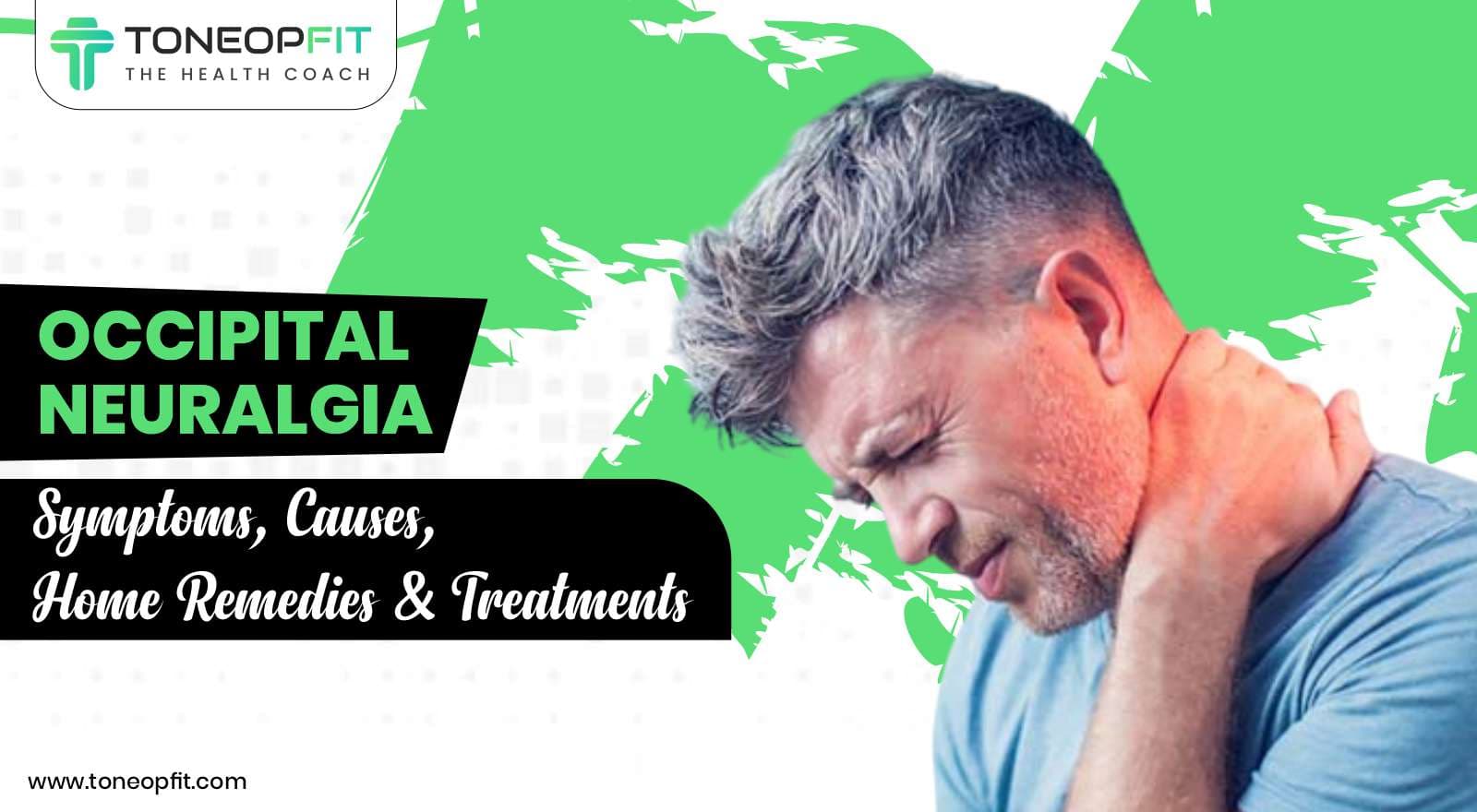Have you ever had a headache in the back of your head? There’s a 0.003% chance that you have a rare headache disorder known as occipital neuralgia.
This headache occurs when the pain originates in the occipital region (the back of the head) and spreads through the occipital nerves. The occipital nerves are at the top of the spinal cord, leading to the scalp that controls your head and neck.
Occipital neuralgia can either be a primary or secondary disorder, meaning it can be the condition itself or a symptom of another disease.
Today, we will talk about occipital neuralgia, its symptoms, causes, and remedies and treatments.
Table Of Contents
- What Is Occipital Neuralgia?
- Occipital Neuralgia's Symptoms: 7 Indicators To Look Out For
- 9 Reasons Behind Occipital Neuralgia Headache
- Occipital Neuralgia Natural Remedies To Do At Home
- Occipital Neuralgia Treatment Plans—Surgical & Non-Surgical
- Expert’s Advice
- The Final Say
- FAQS
- References
What Is Occipital Neuralgia?
Occipital neuralgia is a headache that can have symptoms similar to other types of headaches. The pain originates in the occipital region or the back of the head and spreads through the occipital nerves. Occipital neuralgia often overlaps with migraines, and people with chronic migraines or tension-type headaches may also experience this condition.
Occipital neuralgia is caused due to irritation, inflammation, or injury to the occipital nerves that pass through the scalp. The pain starts at the top of the neck or the back of the head and can radiate behind the eyes and across the scalp. It includes sudden bursts of pain with or without ongoing headache.
Occipital neuralgia can either be a primary or secondary disorder, meaning it can be the condition itself or a symptom of another disease. Although occipital neuralgia is not life-threatening, it is discomforting. However, there are several treatment options that can help you successfully manage the symptoms and pain of occipital neuralgia.
Also Read: 12 Yoga Poses For Migraines With Forms & Pressure Points To Relieve Pain!
Occipital Neuralgia's Symptoms: 7 Indicators To Look Out For

Occipital neuralgia symptoms can be short or long-lasting. The most common symptoms are:
1. Headache
The most identifiable and common symptom of occipital neuralgia is a severe, shooting or throbbing pain at the base of the head. This pain may last a minute or several hours. Sometimes, certain movements or pressure to the neck can trigger this pain, which can be accompanied by dizziness, numbness and tingling in the area.
2. Sensitive Scalp
The scalp may become hypersensitive to touch. Light activities like brushing your hair or putting your head on a pillow can cause pain or discomfort.
3. Eye Pain
This pain may radiate to the eyes and feel like a headache behind the eyes. Also, blurred vision, light sensitivity and other vision problems may occur.
4. Numbness or Tingling in the Scalp
Some people experience numbness or tingling in the scalp. Because of this, people can feel pain.
5. Feeling Of Fullness Or Pressure In The Head
Some people with this condition may experience a feeling of fullness or pressure in the head, which can cause pain.
6. Sensitivity To Light
Similar to migraines, some occipital neuralgia patients may experience photophobia or sensitivity to light.
7. Visual Disturbances
In rare cases, intense pain can lead to visual symptoms like blurred vision.
Also Read: 5 Effective Exercises For Occipital Neuralgia And Other Measures To Cure It
9 Reasons Behind Occipital Neuralgia Headache
Here are more detailed causes for occipital neuralgia headaches:
1. Injury
An injury to the neck or back of the head, like a whiplash, can damage the nerves and lead to occipital pain.
2. Muscle Problems
Tight muscles in the neck and back of the head can sometimes pinch or trap the occipital nerves, leading to occipital neuralgia.
3. Cervical Spine Disorders
Conditions like degenerative disc disease, cervical spondylosis and herniated discs can put pressure on the occipital nerves, leading to pain.
Also Read: 10 Cervical Strengthening Exercises For Neck Stability And Flexibility
4. Tension Headaches
Tension headaches can contribute to occipital neuralgia by causing muscle tension and tightness in the neck and upper back, which may irritate or compress the occipital nerves.
5. Inflammation
Inflammation in the occipital nerves can lead to occipital neuralgia. This inflammation causes sharp, shooting pain at the back of the head, neck, or behind the eyes.
6. Blood Vessel Disorders
Conditions like high blood pressure or atherosclerosis can cause blood vessels to narrow, leading to pain in the occipital region.
7. Tumours
In rare cases, tumours can compress the occipital nerves, leading to occipital neuralgia.
8. Genetics
Some people may have a genetic predisposition to occipital neuralgia development.
9. Medical Conditions
Certain conditions increase the risk of developing secondary occipital neuralgia, such as:
- Osteoarthritis
- Tumours that grow on nerve roots
- AVM (arteriovenous malformation)
- Brain aneurysm
- Brain tumour
- Meningitis
- Sleep disorders
- Stroke
- Sinusitis (inflammation of the sinuses)
- Trigeminal neuralgia
- Rheumatoid arthritis
- Gout
- Infection
Also Read: 5 Targeted Exercises For Meralgia Paresthetica: Treatment Options And Insights
Occipital Neuralgia Natural Remedies To Do At Home
Here's how you can ease the painful symptoms of occipital neuralgia with these remedies:
1. Apply Ice/Heat Therapy
Ice therapy can reduce local inflammation and relieve pain. When you lie down, tuck an ice pack under the base of your skull to relieve occipital neuralgia headache.
However, heat therapy, such as an electric heating pad, may provide more relief. Applying heat to the affected area dilates local blood vessels, increasing blood flow to the neck and reducing muscle tension.
2. Treat Yourself To A Neck Massage
Have someone give you, or give yourself, a neck massage at the base of your skull and shoulders to soothe tense muscles and release tension. Stop immediately if the massage makes your pain worse.
Also Read: 6 Best Simple And Effective Yoga For Neck Pain Relief
3. Do Chin Exercises Regularly
Chin exercises, such as chin tucks, chin raises, and neck stretches, can help alleviate occipital neuralgia by strengthening neck muscles, improving spinal alignment, and reducing muscle tension around the cervical spine.
Occipital Neuralgia Treatment Plans—Surgical & Non-Surgical
The options for occipital neuralgia treatments are:
1. Non-Surgical Treatments
Non-surgical treatments that can effectively manage occipital neuralgia are:
1. Medications
One of the most common treatment methods for occipital neuralgia is medication. Over-the-counter pain relief meds, such as ibuprofen and acetaminophen, can help relieve pain. At the same time, you can use prescription drugs to target specific symptoms. These can be tricyclic antidepressants and anticonvulsants. You can also use corticosteroid injections to reduce pain in the affected area.
2. Physical Therapy
Physical therapy may strengthen the muscles in your neck and shoulders and reduce pressure on the occipital nerves. You can also use stretching and massage to relieve pain and improve range of motion.
Also Read: 5 Effective Physiotherapy Exercises For Lower Back Pain Relief
3. Nerve Block
A nerve block involves injecting a local anesthetic to the affected area. The anaesthetic helps numb the nerves temporarily, providing temporary pain relief and helping diagnose the condition.
4. Acupuncture
This traditional Chinese medicine technique involves using fine needles to relieve pain. Doctors insert these needles into specific points on the body, which helps stimulate the nervous system and promote healing.
5. Chiropractic Care
Chiropractors use manual adjustments to the spine that help relieve pain and improve range of motion.
6. Transcutaneous Electrical Nerve Stimulation (TENS)
This non-invasive treatment uses electrical impulses. It helps stimulate the nerves and reduces pain.
2. Surgical Treatment
There are some types of occipital neuralgia surgery:
1. Occipital Nerve Decompression Surgery
This surgery involves releasing pressure on the occipital nerves by removing any compressive structures, such as bone spurs or tight muscles at the base of the skull. This surgery aims to reduce nerve irritation and provide long-lasting relief from the sharp, shooting pain of occipital neuralgia. It is typically recommended for individuals who have not responded to conservative treatments like medications or nerve blocks.
2. Neurostimulation (Occipital Nerve Stimulation)
Neurostimulation may be considered in cases of chronic and severe occipital neuralgia. It involves implanting a device under the skin to deliver pulses to the occipital nerves. The electrical stimulation helps interrupt pain signals, providing relief from the ongoing pain associated with occipital neuralgia.
Expert’s Advice
Occipital neuralgia can be a challenging condition to live with, but with the right diagnosis and treatment plan, individuals can find relief from its debilitating symptoms. Stress reduction techniques, regular exercise, and maintaining good posture can help prevent and manage symptoms. Treatment options such as hot and cold therapy, stretching, and massage provide pain relief for many people. However, consider going to a doctor if the symptoms and pain are persistent.
Health Expert
Lavina Chauhan
The Final Say
Occipital neuralgia is a type of nerve pain that often leads to headaches. It can occur due to pressure or damage to the occipital nerves. These nerves start in the neck and run along the sides of the head. In most cases, the pain will improve with home remedies or medications. If you have chronic pain in the back of your neck or head, it is vital to see a doctor. You need to do this as soon as possible to find out the cause and recommend the right treatment.
FAQs
1. What is the fastest way to cure occipital neuralgia?
The quickest way to get relief from occipital neuralgia is physical therapy, massage therapy, or heating pads/devices placed over the area of pain.
2. What can be mistaken for occipital neuralgia?
Occipital neuralgia is easily confused with other conditions, such as migraines and tension headaches. It is, therefore, essential to get an accurate diagnosis and prescription for appropriate treatment.
3. How long can occipital neuralgia symptoms last?
The pain of occipital neuralgia can last for just a few seconds, or it can affect you for hours.
References
- https://www.ninds.nih.gov/health-information/disorders/occipital-neuralgia#:~:text=The%20pain%20usually%20begins%20in,cause%20severe%20pain%20(allodynia).
- https://my.clevelandclinic.org/health/diseases/23072-occipital-neuralgia
- https://www.medicalnewstoday.com/articles/320143#summary
- https://lonestarneurology.net/headaches/what-is-occipital-neuralgia/
- https://www.spine-health.com/blog/occipital-neuralgia-what-it-and-how-treat-it
- https://pure-medical.co.uk/occipital-neuralgia
- https://www.precisionhealth.com.au/healthcare-services/advanced-neurosurgery-spinal-surgery/conditions-treated/pain/occipital-neuralgia/
- https://blog.themigrainereliefcenter.com/treat-occipital-neuralgia-pain
- https://www.american-hospital.org/en/pathologie/what-occipital-neuralgia
- https://www.algolojiuzmani.com/occipital-neuralgia-symptoms-causes-diagnosis-and-treatment/
About ToneOp Fit
ToneOp Fit is a platform dedicated to improving and maintaining good health through a comprehensive range of goal-oriented health plans with up to 3 Coach support. With a range of Weight Management, Medical Condition, Detox Plans, and Face Yoga Plans, the app also provides premium health trackers, recipes and health content. Get customised diet, fitness, naturopathy & yoga plans and transform yourself with ToneOp.









































